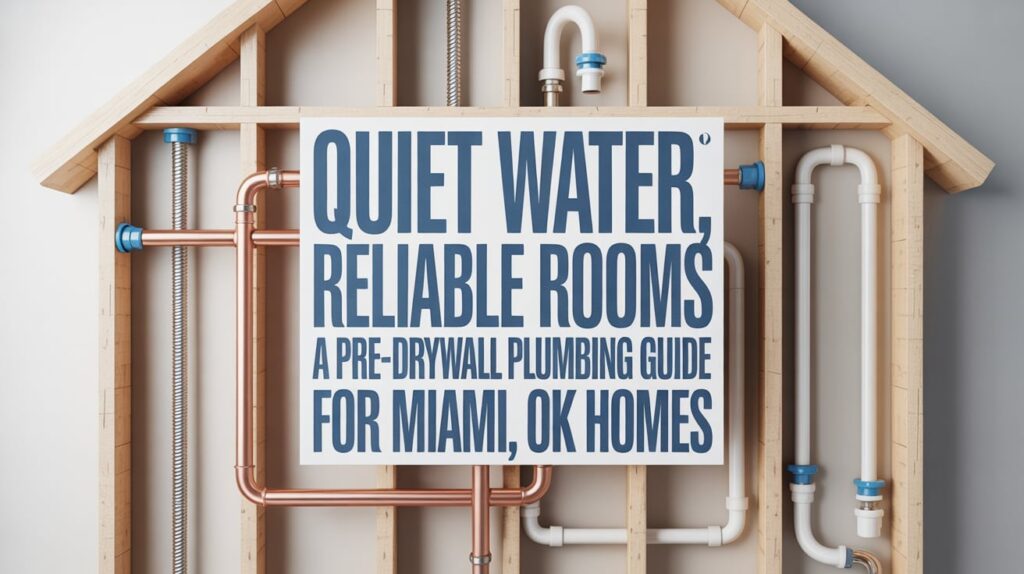Good builds feel calm because water moves quietly where it should. Before drywall closes, a short, focused plumbing walkthrough protects living spaces, finishes, and budgets. Miami’s weather, soil, and wind push systems harder than a catalog plan admits, so small checks now prevent pipe leaks, weak showers, and surprise repairs later.
Map Water Loads Before The Walls Close
Start with a simple sketch that matches daily life. Mark’s simultaneous demands – showers, laundry, irrigation garden. Confirm trunk and branch sizes to keep pressure stable when two fixtures run at once. Walk the lines from the meter to the farthest fixture and back to the heater. Look for long detours around framing, tight bends that restrict flow, and spots where pipes touch studs without protective plates. The goal is a layout that delivers steady pressure without hum, rattle, or heat loss.
Shortlisting licensed crews saves time when schedules compress. A verified local directory of Plumbers in Miami, OK helps compare providers by service scope, hours, and community feedback, so the project keeps moving. Ask about experience with pre-drywall punch lists, preferred materials for branch lines, and how they protect studs and finishes during late changes. Clear answers signal predictable work once walls close and floors arrive.
Pressure, Flow, And Noise That Don’t Fight Family Routines
Pressure feels like comfort – a kitchen sprayer that reaches corners, a shower that rinses fast, laundry that fills on cue. Set the home’s regulator near the meter to a target the plumbing plan supports, then confirm it at the farthest hose bib. Use isolation valves at each wet room, so small fixes never shut down the whole house. Mount the water heater on isolation pads and route hot lines with gentle sweeps to reduce vibration. Where pipes cross quiet rooms, add sleeves and clips that keep lines from tapping studs. A calm loop protects sleep, study, and conversations without asking anyone to plan around plumbing.
What To Check Room By Room
- Kitchen: verify shutoffs at sink and dishwasher, plus a clean run for filtered water or an ice maker.
- Laundry: install a drain pan with an alarm, and set valves at a comfortable height to prevent wrist strain.
- Primary bath: confirm shower mixing valve height, niche placement away from exterior walls, and access to shutoffs.
- Hall bath: keep supply lines clear of toe-kick drawers, and add backing for future grab bars.
- Utility spaces: label lever directions on main and branch shutoffs, then photograph for a home file.
Drainage And Venting That Age Well
Drains carry more than water – they carry noise into drywall if the venting and slope are off. Confirm trap arm lengths and slopes with a small level, and keep vents away from bedroom headwalls when options exist. Use long-turn fittings on horizontal changes, so clogs stay rare and cleanouts actually work. In older neighborhoods near heavy clay, protect under-slab routes with sand bedding and thoughtful expansion joints. A quiet, properly vented stack means fewer gurgles, fewer slow drains, and less pipe cleaning in the evenings.
Outdoor Lines And Freeze Readiness Without Guesswork
Miami sees quick swings that punish exposed runs. Place frost-proof hose bibs on the leeward side where possible, and add vacuum breakers to protect potable lines during garden tasks. Route irrigation tie-ins with a clear winterizing path, so seasonal shut-downs take minutes. For patios and potting benches, plan a dedicated hard-water tap for power-washing tools and stone, while keeping softened or filtered water for cooking lines. Label every exterior shutoff and photograph each location before backfill.
Closeout Papers Worth Keeping On The Fridge
A good plumbing handoff reads like a map that anyone can follow. Ask for a one-page summary with regulator setting, heater capacity, pipe materials by zone, fixture brand, cartridge type, and the locations of cleanouts and shutoffs. When a small drip appears or a filter needs replacement, the right part and the right valve show up fast. Future upgrades run smoothly because the plan already lives in the house, not only in a contractor’s memory.
A Build That Feels Finished From Day One
Homes win when design and water work as partners. Pre-drywall checks tune pressure, quiet lines, and confirm drainage, so rooms feel complete when furniture arrives. Families cook, bathe, and host without negotiating with infrastructure, because choices behind the walls support what happens in front of them. When tasks exceed a weekend toolkit, local specialists step in while schedules and budgets stay steady.

